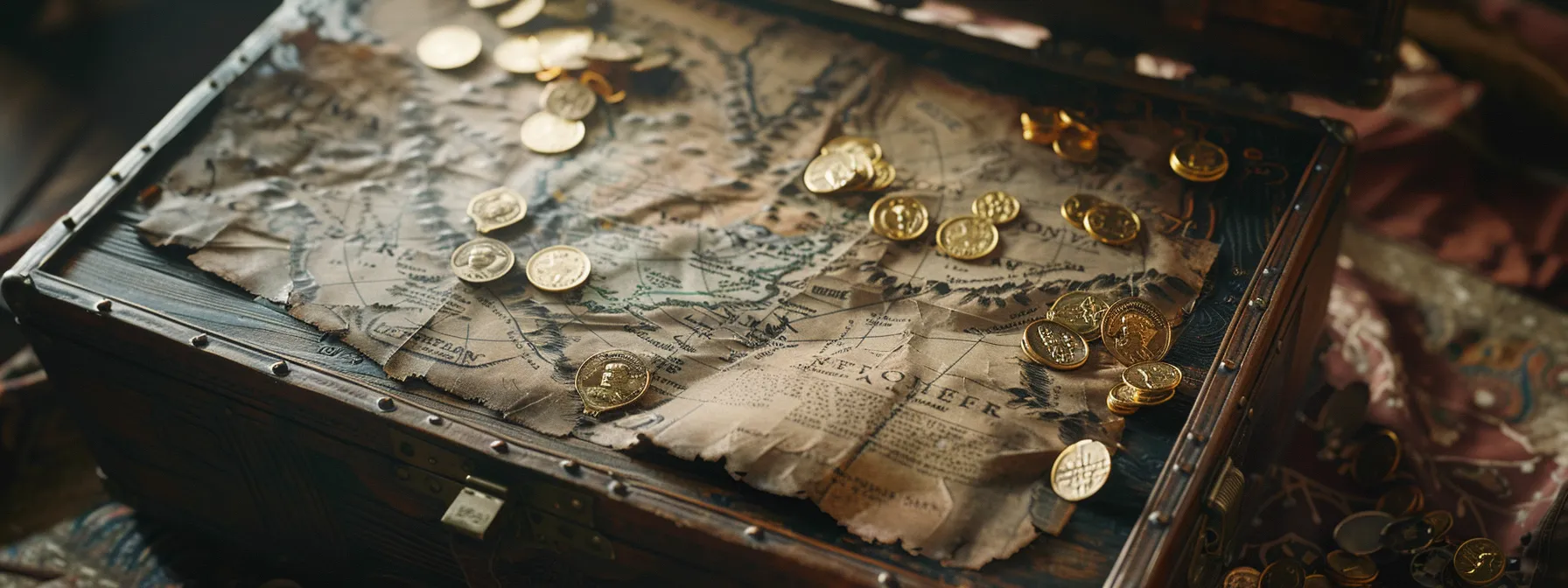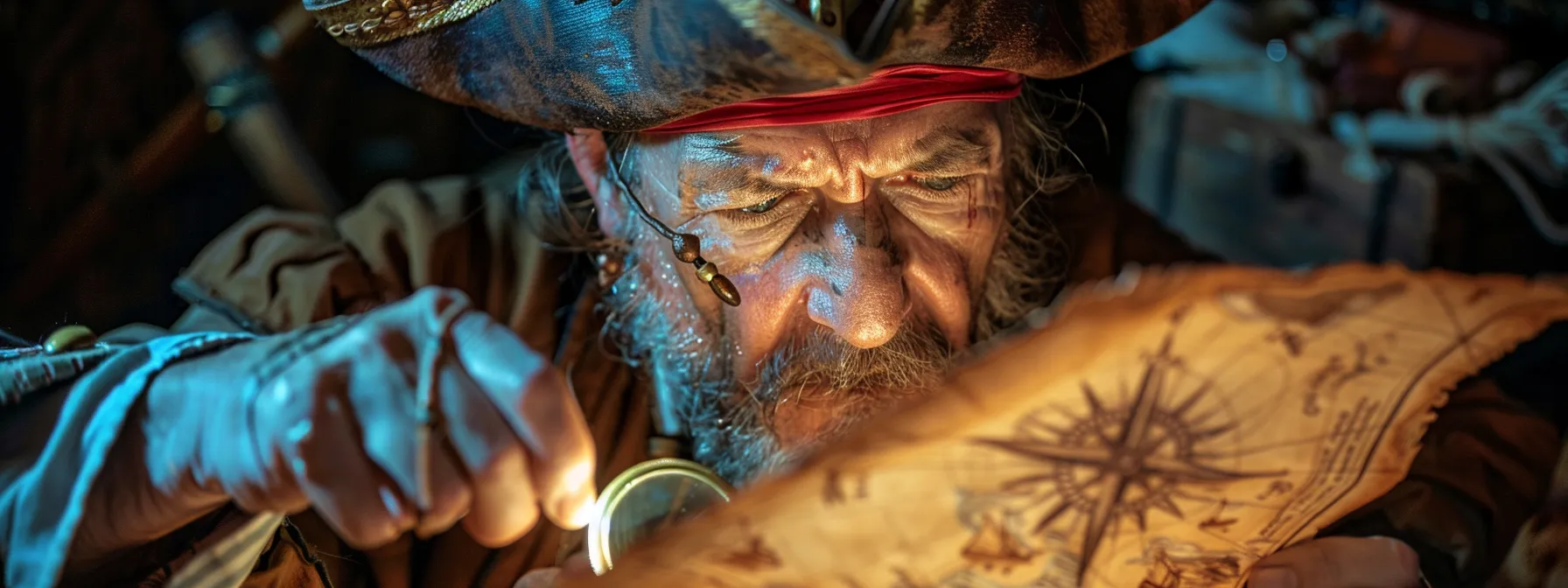

Have you ever wondered about the lost treasures that still elude treasure hunters today? From the legendary El Dorado to the mysterious Knights Templar treasures, these enigmas captivate the imagination and fuel the search for hidden artifacts. In this post, I’ll delve into fascinating tales, including the Lost Amber Room and Captain Kidd’s hidden bounty. By exploring these mysteries, you’ll enhance your understanding of treasure hunting while discovering tips to better your own pursuits. Join me as we tackle these intriguing stories, which may help solve your curiosity about lost treasures and the legends behind them.
Key Takeaways
- the legend of el dorado highlights humanity’s timeless quest for hidden treasures
- many historical expeditions faced significant challenges and returned empty-handed
- modern technology aids treasure seekers in exploring potential hiding places for lost artifacts
- the ark of the covenant‘s disappearance continues to inspire both faith and treasure hunting adventures
- cultural heritage is deeply connected to the pursuit of lost treasures throughout history
Unearthing the Legend of El Dorado

About Us The legend of El Dorado has captivated treasure hunters and historians alike, originating from tales of a golden kingdom. I’ll discuss the various historical expeditions aimed at finding this mythical place and their often disappointing outcomes Metal Detecting Guide. In addition, I’ll explore modern research efforts pinpointing possible locations of El Dorado and examine how this legend has influenced global culture.
The Origins of the Golden Kingdom Myth
The myth of El Dorado traces its origins to the early 16th century, spurred by stories of a ruler covered in gold dust, who would make offerings to the gods in a lake. This tale caught the imagination of many, leading to numerous treasure hunting expeditions fueled by the allure of unimaginable wealth, much like the stories surrounding the Isabella Stewart Gardner Museum heist or the rumored treasures of the Temple in Jerusalem. Each of these legends shares a common thread—the tantalizing promise of lost riches that drives explorers to seek what may never be found.
Over time, the legend evolved, turning the golden king into a lost city, sparking adventures across South America. Spanish conquistadors, along with treasure hunters, ventured into jungles searching for El Dorado, often ending their journeys in disappointment. Modern research continues to investigate locations in Colombia and Venezuela, with many believers, like those hunting for treasure in Saint Petersburg, still captivated by the hope of discovering these lost treasures; the quest echoes a timeless fascination with what lies hidden beneath the earth.
Historical Expeditions and Their Outcomes
Throughout history, numerous expeditions have sought the lost riches of El Dorado, with many explorers facing daunting challenges. One notable effort was undertaken by the Spanish conquistador Gonzalo Pizarro in the 1530s, who led a trek through the treacherous jungles of Ecuador. Despite his ambitions and hopes for wealth, Pizarro’s expedition ultimately returned empty-handed, reflecting the harsh realities of treasure hunting. This pattern of failure has been echoed in other treasure pursuits, including attempts to locate artifacts from the Qin Shi Huang dynasty, demonstrating how even the most determined seekers can encounter insurmountable obstacles.
The allure of El Dorado has continued to inspire modern treasure hunters, yet the fate of past expeditions highlights a common theme: the quest for riches often leads to disappointment. Following World War II, some adventurers from the Soviet Union joined the frenzy, believing that vast wealth might still remain hidden in the South American jungle. Much like infamous art theft cases or rumors of lost treasures, such as the rumored wealth from the Isabella Stewart Gardner Museum, these undertakings show how the pursuit of hidden fortunes can captivate imaginations, while reminding us that the journey may be filled with challenges rather than rewards.
Modern Research and Possible Locations
Modern research efforts have shifted the focus of El Dorado searches to specific areas in Colombia and Venezuela, where new technologies and techniques enhance the exploration for buried treasure. Archaeologists and treasure hunters alike have studied ancient routes and mining sites, hoping to uncover remnants of lost civilizations that once thrived in these regions. Tools such as satellite imagery and ground-penetrating radar have proven valuable in identifying possible locations where treasures, including gold and perhaps even artifacts like amber, might still lie hidden.
The quest for El Dorado continues to stir the imagination, much like the ongoing search for other fabled treasures such as the holy grail or the elusive riches of the Catherine Palace. As researchers collaborate with historians and local communities, they explore both the myths and realities surrounding these treasures. By blending traditional methods with cutting-edge technology, they keep the spirit of discovery alive, reminding us of the enduring allure of lost treasures around the globe:
- The legend of El Dorado began with tales of a golden kingdom.
- Historical expeditions faced significant challenges and often returned empty-handed.
- Modern research employs technology to investigate potential locations.
- Collaborations with local communities enhance the study of myths and artifacts.
El Dorado’s Influence on Global Culture
The legend of El Dorado has profoundly influenced global culture, inspiring countless stories, films, and artistic expressions. This mythical city of gold has captivated the imagination of many, linking it to themes of adventure and exploration that often feature ships traversing treacherous waters, reminiscent of piracy tales. Additionally, the concept of lost treasures and covenants has drawn parallels to epic narratives from the Roman Empire, showcasing our timeless fascination with the allure of hidden wealth.
As a treasure hunter, I see the impact of El Dorado extending beyond its initial tale. It symbolizes the pursuit of dreams and the human spirit’s desire for exploration. Whether it’s through movies that portray daring expeditions or literature that brings to life the adventures of those seeking fortune, the legend endures, reflecting our collective intrigue with lost treasures around the globe. This ongoing fascination echoes through various cultural narratives, driving a deeper understanding of history and adventure:
- The legend of El Dorado inspires numerous artistic expressions.
- It connects to themes of adventure and exploration, often featuring ships and piracy.
- The pursuit of lost treasures resonates with stories from the Roman Empire.
- El Dorado symbolizes human aspiration and the spirit of discovery.
As we dig deeper into legends, another tale calls us from the shadows—the lost Amber Room. Its glow once dazzled the world, but now it hides in whispers, waiting for brave souls to uncover its secrets.
The Mystery of the Lost Amber Room

The Amber Room, a stunning creation known for its intricate design and historical significance, vanished during World War II’s turbulent times. I’ll explore clues and theories about its whereabouts, paralleling other legendary treasures like the Ark of the Covenant and the Copper Scroll. Additionally, I’ll discuss restoration efforts and memorials honoring this lost masterpiece, shedding light on its enduring legacy.
Creation and Historical Significance
The Amber Room, often regarded as one of the lost treasures of the world, was a stunning combination of artistry and craftsmanship. Created in the 18th century, it was designed by German craftsman Andreas Schlüter and later completed by Bartolomeo Rastrelli. This breathtaking chamber was adorned with amber panels, gold leaf, and mirrors, reflecting the grandeur of the Baroque period and offering a glimpse into the artistic achievements of that era. When I think about its significance, it reminds me of the impact of other treasures like the Ghent Altarpiece or the Dead Sea Scrolls, each signifying human creativity and history.
The disappearance of the Amber Room during World War II adds another layer to its storied past. Nazi soldiers looted this masterpiece, disappearing without a trace and leaving behind a mystery that still intrigues treasure hunters and historians alike. Just as the search for the Ten Commandments or the ongoing scavenger hunts for legendary artifacts like the Copper Scroll captures imaginations, the plight of the Amber Room inspires continued interest and restoration efforts. We may never fully uncover its secrets, yet the story of the Amber Room endures:
- The Amber Room was created in the 18th century with intricate amber panels.
- Nazi soldiers looted it during World War II, leading to its mysterious disappearance.
- The quest for its recovery resembles other legendary searches in history.
Disappearance During Turbulent Times
The disappearance of the Amber Room during World War II stands as a stark reminder of how turbulent times can erase cultural treasures. When Nazi soldiers invaded, they swiftly looted the Amber Room, taking its exquisite amber panels, gold accents, and mirrors. Its loss is reminiscent of other historical tragedies involving precious artifacts, such as the vanishing treasures from the Second Temple, where invaluable silver was taken. The knowledge that such artistry can vanish in chaos drives my passion as a treasure hunter, making me appreciate the need for preserving cultural heritage amidst turmoil.
Clues and Theories About Its Whereabouts
The search for the lost Amber Room has generated various clues and theories about its potential whereabouts, particularly in areas that could have provided safe hiding grounds during the chaos of World War II. One theory proposes that the room might have been concealed in a lake near the Baltics, where it could evade detection from the Nazi forces. Additionally, other suggestions point to artifacts being transported to places like Beijing, as fleeing members of the Jewish community sought refuge with their treasures in hopes of preserving cultural heritage amid turmoil. These theories highlight the complexities and uncertainties that surround such a legendary artifact.
Many believe that the Amber Room was hidden or buried under incredible scrutiny, perhaps with the involvement of secret organizations like the Order of St Patrick, further complicating recovery efforts. Some treasure hunters argue that connections to crown jewels across Europe may also provide insights into its fate, suggesting that artifacts could have been linked to wider efforts to safeguard treasures from theft during the war. While the quest continues, these insights not only deepen our understanding of the Amber Room‘s tragic history but also underscore the enduring hope of discovering lost treasures around the globe.
Restoration Efforts and Memorials
Restoration efforts for the Amber Room have always focused on recreating its lost beauty after its notorious looting during World War II. In the 1990s, a significant project in Russia aimed to rebuild the chamber using original materials and craftsmanship techniques that mirror those used by craftsmen like Andreas Schlüter. This initiative not only highlights the importance of archaeology in recovering cultural heritage but also serves as a reminder of the devastating loss that figures like Ivan the Terrible experienced when treasures, such as the Amber Room, vanished under chaotic circumstances.
Memorials honoring the Amber Room provide visitors with a deeper understanding of its historical significance. I appreciate how these memorials serve to educate the public about the ambivalence of lost treasures and the impacts of conflict, much like the mystery surrounding treasures like the Masamune sword. Additionally, sites in Königsberg, where the Amber Room was originally installed, have become focal points that commemorate its exquisite artistry and the tragedies behind its disappearance, ensuring that the story of the Amber Room remains alive in our collective memory.
- The Amber Room was famously looted during World War II.
- Restoration efforts focused on recreating its original beauty.
- Memorials educate the public about its historical significance.
- Königsberg serves as a key site in remembering the Amber Room.
- The story reflects the impact of looting on cultural heritage.
The search for the lost Amber Room reveals how history hides its treasures. Next, we turn to the Knights Templar, a secretive order whose lost riches spark curiosity and adventure.
Tracing the Treasure of the Knights Templar

The Knights Templar rose to prominence in the Middle Ages, becoming known for their wealth and military prowess. Legends of hidden vaults and artifacts, including valuable items like the famed sword and treasures reminiscent of the Green Vault or those rumored to be linked to Alexandria, have fueled modern-day searches and investigations. I’ll share how these tales impact contemporary storytelling, illustrating the enduring fascination with Templar treasures.
The Rise of the Templar Order
The Knights Templar emerged as a powerful military and financial force in the Middle Ages, primarily established to protect pilgrims traveling to the Holy Land. As I learned more about their rise, it became clear that their unique structure, combining monastic life with military duties, set them apart from other orders. This blend of spirituality and combat allowed them to accumulate significant wealth and land, establishing a legacy that still fascinates us today.
Legends of Hidden Vaults and Artifacts
The legends surrounding the hidden vaults of the Knights Templar have sparked intrigue among treasure hunters and historians. Many believe these vaults might contain not only material wealth but also sacred artifacts, such as the Holy Grail or ancient religious texts. As I’ve delved into these stories, it’s evident that their allure lies in the combination of treasure and mystery, leading many adventurous seekers to search for clues across Europe, particularly in locations like Rosslyn Chapel and the ruins of Temple Church in London.
Modern-Day Searches and Investigations
In my exploration of Templar treasures, I’ve observed how modern-day searches are increasingly reliant on technology, such as ground-penetrating radar and 3D mapping. These tools enable treasure hunters and historians to delve into areas that would have once been considered too challenging to investigate. For instance, recent investigations at sites like Rosslyn Chapel have revealed intriguing anomalies that could lead us closer to the elusive Templar riches.
The collaborative efforts between amateur treasure hunters, archaeologists, and historical societies have been invaluable in uncovering new leads and sharing knowledge. By organizing community digs and workshops, many enthusiasts are engaging with local history while pursuing their passion for treasure hunting. This approach not only enhances our understanding of the Knights Templar but also fosters a sense of shared adventure that drives us all to discover the secrets hidden beneath our feet.
Impact on Contemporary Storytelling
The stories surrounding the Knights Templar have influenced contemporary storytelling in various ways, from films to novels. I find that these tales create an exciting blend of adventure and history, drawing in audiences with the tantalizing notion of hidden treasures and secret societies. Works like “The Da Vinci Code” vividly illustrate how these legends can captivate the public’s imagination, inspiring further exploration into the rich history and culture of the Templars.
As a treasure hunter, I appreciate how the Templar legends serve as a backdrop for inspiring narratives that encourage deeper engagement with our past. The intrigue of the Templar Order and its alleged lost artifacts motivate both amateur enthusiasts and seasoned researchers to share their stories—highlighting a collective passion for discovery and the pursuit of hidden wealth. In this way, the tales of the Knights Templar not only keep the spirit of adventure alive but also foster a greater appreciation for the historical significance of treasures often overlooked in mainstream culture.
The treasure of the Knights Templar sparked curiosity like a flame. Yet, tales of the Lost Inca Gold, shrouded in mystery and allure, promise a different kind of adventure waiting just over the horizon.
The Enigma of the Lost Inca Gold

The wealth and resources of the Inca Empire were immense, but much of it vanished following the conquest. In this section, I’ll discuss the lost riches of the Incas, including the legendary city of Paititi, often described as a city of gold. Additionally, I’ll cover ongoing expeditions and discoveries aimed at unearthing these elusive treasures and the fascinating stories they tell.
Wealth and Resources of the Inca Empire
The Inca Empire was rich in resources, largely due to its advanced agricultural practices and extensive mining operations. I’ve learned that they cultivated a variety of crops, including potatoes, maize, and quinoa, which supported a large population and allowed for significant trade. Gold and silver played a crucial role in their society, not only as currency but also as materials for religious offerings and intricate artistry that showcased their impressive craftsmanship.
Following the Spanish conquest, vast quantities of Inca gold and silver were looted, leaving many to wonder about the treasures that still remain hidden. The legend of the lost city of Paititi often emerges in conversations about Inca wealth, prompting treasure hunters like myself to explore its possible location. The allure of these riches drives continuous expeditions, and there are stories about the Empires’ complex roads used to transport gold and silver across the Andes, leading to even more questions about what treasures might still be buried beneath the earth:
- The Inca Empire thrived on agriculture and mining.
- Gold and silver were integral to their economy and culture.
- The Spanish conquest led to the loss of immeasurable wealth.
- Legends of the lost city of Paititi continue to inspire treasure hunting efforts.
The Conquest and the Vanishing Riches
The conquest of the Inca Empire by Spanish conquistadors in the 16th century marked a significant turning point in the history of lost treasures. When I look into this era, it’s clear that vast amounts of gold and silver were seized, leading to the near-total disappearance of this once-prosperous civilization’s wealth. The Spanish were drawn by tales of unimaginable riches, ultimately plundering not just material wealth, but also erasing much of the cultural legacy built around these treasures.
The Legend of Paititi: A City of Gold
The legend of Paititi, often described as a city of gold, has fueled my passion as a treasure hunter for years. This mythical city is believed to be hidden within the dense jungles of the Andes, safeguarded by natural barriers and the remnants of Inca civilization. Its allure draws many explorers and historians alike, all eager to uncover the riches and ancient wisdom that may lie hidden beneath the earth.
As I explore this legend, I uncover stories of brave adventurers who have risked their lives in search of Paititi. They followed ancient Inca trails and rivers, guided by the whispers of indigenous people who still speak of the city’s existence. Each journey not only seeks material wealth but also aims to reconnect with the history and culture of the Inca Empire, reminding us that the quest for treasures is deeply intertwined with understanding our past:
- The legend of Paititi suggests a hidden city filled with gold.
- Many explorers have undertaken dangerous journeys into the jungles of the Andes.
- Indigenous stories continue to inspire seekers of Inca treasures.
- Adventurers emphasize the importance of understanding Inca culture in their pursuit.
Ongoing Expeditions and Discoveries
Ongoing expeditions to uncover the lost Inca gold continue to draw treasure hunters and historians into the challenging terrains of the Andes. Recently, several teams have utilized advanced technology such as drone surveys and 3D mapping to explore potential sites associated with the city of Paititi. By leveraging these modern tools, we can access areas that would have once been nearly impossible to investigate, thus increasing our chances of discovering remnants of this elusive treasure.
As I join these expeditions, I often find that collaboration with local indigenous communities enhances our search efforts significantly. Their knowledge of the land and oral histories provide valuable insights that guide our explorations, helping us locate paths once used by the Incas. This partnership not only aims to uncover lost treasures but also fosters a deeper appreciation for the rich cultural heritage embedded in the search for Inca gold.
The thrill of hunting for lost Inca gold never fades, but some say a greater prize lies ahead. The stories of Captain Kidd’s hidden bounty promise adventure and discovery, drawing treasure hunters deeper into the mystery.
Pursuing Captain Kidd’s Hidden Bounty

Captain William Kidd was a notorious figure whose life was filled with adventure and controversy. His stories of buried treasure have sparked countless treasure hunts across oceans, captivating many seekers like myself. In this section, I’ll explore notable treasure hunts and findings tied to Kidd’s legacy in maritime history, offering practical insights into the enduring allure of his hidden bounty.
The Life of Captain William Kidd
Captain William Kidd, originally a reputable privateer, became embroiled in infamous tales of piracy that marked his legacy. Born in Scotland in the late 17th century, Kidd started his career with the intention of hunting pirates, a quest that ironically transformed him into one himself as he turned to piracy during hard times at sea. His life is often viewed through the lens of adventure and moral ambiguity, showcasing the thin line between hero and villain that many treasure hunters may encounter in their own pursuits.
Kidd’s most notorious act was burying treasure that he amassed from his voyages, which has spurred countless treasure hunts to this day. The hunt for Kidd’s hidden bounty is often framed by the stories surrounding his life, drawing enthusiasts like myself into the search for both riches and adventure. The allure of his lost treasure reflects a deeper yearning for discovery, reminding us that the pursuit of these treasures can be just as thrilling as the treasures themselves.
Tales of Buried Treasure Across Oceans
The tales of buried treasure from Captain Kidd have captivated treasure hunters like me, sparking countless quests across the world’s oceans. Many believe that Kidd hid his amassed wealth somewhere in the Caribbean, leading to numerous expeditions fueled by excitement and hope. Stories of pirates burying gold and silver evoke a sense of adventure, emphasizing the allure of finding lost riches beneath sandy shores.
As I explore these legends, I constantly seek out relics and resources that might shed light on Kidd’s secret locations. Local lore often plays a vital role, providing hints that guide our explorations. The journey itself becomes as exciting as the potential treasure, as each expedition uncovers not just the search for gold, but the history and mystery surrounding these legendary figures:
- Captain Kidd was believed to have buried treasure in the Caribbean.
- Many treasure hunts continue today, driven by tales of lost riches.
- Local legends contribute valuable insights for treasure hunters.
Notable Treasure Hunts and Findings
As I immerse myself in the world of treasure hunting, the quest for Captain Kidd’s lost bounty stands out with its rich history and captivating tales. One notable hunt took place in the early 20th century when treasure hunters flocked to the Caribbean, drawn by stories of Kidd’s hidden treasures in places like Oak Island and the shores of bay along Tortuga. These expeditions often faced difficulties, from harsh weather to local myths that complicated the search for Kidd’s hidden gold.
More recently, in 2007, a team of modern treasure hunters discovered artifacts on Gardiner’s Island, New York, believed to be linked to Captain Kidd. This finding ignited renewed interest in his legendary treasure and showcased how advancements in technology, like metal detectors, can aid our search for lost riches. The quest for Kidd’s hidden bounty continues to inspire me and many others, reminding us that historic treasures might still await discovery:
- Treasure hunters in the early 20th century searched for Kidd’s gold in the Caribbean.
- Expeditions faced various challenges, including weather and local lore.
- In 2007, significant artifacts were found on Gardiner’s Island.
- Modern technology has enhanced treasure hunting efforts.
Legacy in Maritime History
Captain Kidd’s legacy in maritime history remains a vital part of both treasure hunting and pirate lore. His transformation from privateer to pirate reflects the complexities of life at sea, illustrating the blurred lines between heroism and villainy. As I delve deeper into his story, I realize how Kidd’s adventures sparked a fascination that continues to capture our imaginations, driving treasure hunters like me to explore the mysteries left behind.
This intrigue has not only led to countless treasure hunts but has also significantly influenced maritime culture. Many stories and legends surrounding Kidd have inspired popular literature and films, keeping the allure of piracy alive. This highlights how tales of buried treasure can create a lasting legacy, motivating treasure hunters to seek their fortunes while learning about history and maritime practices. The ongoing tide of exploration reveals the impact of Captain Kidd’s life on the pursuit of treasure today:
- Captain Kidd’s transformation from privateer to pirate drives intrigue in maritime history.
- His story inspires literature and films, highlighting the allure of buried treasure.
- Contemporary treasure hunts reflect the impact of his legacy on exploration and discovery.
With the thrill of Captain Kidd’s hidden bounty still fresh, the tales of ancient relics began to stir my curiosity. The quest for the Ark of the Covenant promised secrets and treasures far beyond those of a mere pirate.
Quest for the Ark of the Covenant

The quest for the Ark of the Covenant is filled with captivating historical accounts and descriptions that highlight its importance. I’ll delve into its cultural and religious significance, explore various theories surrounding its mysterious disappearance, and discuss ongoing efforts to locate this ancient relic. These topics shed light on the enduring intrigue that surrounds one of history’s most sought-after treasures.
Historical Accounts and Descriptions
The Ark of the Covenant, described in biblical texts as a sacred chest that housed the Ten Commandments, has fascinated historians and treasure hunters for centuries. Accounts from sources like the Book of Exodus vividly illustrate its construction and significance, detailing how it was made of acacia wood and adorned with gold. Personally, I find the various historical descriptions captivating, as they emphasize the Ark’s role in ancient Israelite culture as a symbol of divine presence and guidance, which only deepens my interest in uncovering its potential hiding places.
Cultural and Religious Significance
The Ark of the Covenant is significant not only as a religious artifact but also as a cultural symbol that has influenced various traditions and beliefs. It represents the covenant between God and the Israelites, holding immense importance in Judaism and Christianity. Many view it as a direct connection to divine presence, making its mysterious disappearance a matter of deep spiritual intrigue that resonates across generations.
As a treasure hunter, I find myself fascinated by how the search for the Ark has inspired countless quests and narratives. The possibilities surrounding its location, whether believed to be hidden in Jerusalem or housed in Ethiopia, reflect a blend of faith and adventure. Each theory surrounding the Ark’s whereabouts fuels my passion for uncovering lost relics, as they intertwine historical significance with personal belief, enriching my understanding of cultural heritage:
- The Ark symbolizes the covenant between God and the Israelites.
- It holds substantial meaning in both Judaism and Christianity.
- Its disappearance inspires ongoing quests and stories across cultures.
- Connecting faith and history, it draws treasure hunters into its mystery.
Theories on Its Disappearance
Many theories surround the disappearance of the Ark of the Covenant, each suggesting different potential hiding places. One prevailing belief is that the Ark was concealed in a secret chamber beneath the Temple in Jerusalem, intended to protect it from invading forces. This theory resonates with me, as it connects the religious significance of the Ark with the historical turmoil experienced in the region, highlighting the persistent desire to safeguard important cultural artifacts.
Another intriguing theory suggests that the Ark was transported to Ethiopia, where it is rumored to reside in the Church of St. Mary of Zion. As a treasure hunter, I find this possibility particularly fascinating, as it speaks to the enduring legacy of the Ark and its religious importance beyond the boundaries of ancient Israel. The search for the Ark, driven by such theories, ultimately reflects a deeper yearning to connect with our past and restore lost artifacts that hold significant historical and spiritual value.
Efforts to Locate This Ancient Relic
Throughout history, numerous efforts have been made to locate the Ark of the Covenant, driven by its immense cultural and religious significance. Various archaeologists and treasure hunters have explored potential hiding spots, including the sacred grounds beneath the Temple Mount in Jerusalem. As a treasure hunter myself, I find that these investigations often require a delicate balance of historical research and modern technology, such as ground-penetrating radar, to uncover ancient secrets that remain hidden.
Many enthusiasts also explore long-standing theories suggesting the Ark was taken to Ethiopia, currently residing in the Church of St. Mary of Zion. This hypothesis has sparked interest among explorers and researchers, prompting numerous expeditions aimed at tracing its path and verifying historical accounts. I believe that each of these journeys illuminates the captivating stories surrounding the Ark and reflects our collective desire to reconnect with lost treasures from the past:
- Efforts focus on potential hiding spots, including Jerusalem.
- Modern technology aids in uncovering ancient secrets.
- Theories suggest the Ark may reside in Ethiopia.
- Expeditions aim to trace the Ark’s historical path.
Conclusion
Exploring the enigmas of lost treasures around the globe not only captivates our imaginations but also connects us to rich histories and cultural narratives. The stories of El Dorado, the Amber Room, and the Ark of the Covenant illustrate the enduring allure of treasure hunting, showcasing how our quests for lost riches reveal deeper insights into human aspiration and adventure. By engaging with these legends, we foster a greater appreciation for cultural heritage and the quest for knowledge. Ultimately, the pursuit of these treasures encourages us to embrace the excitement of discovery and the shared human story behind each artifact.


